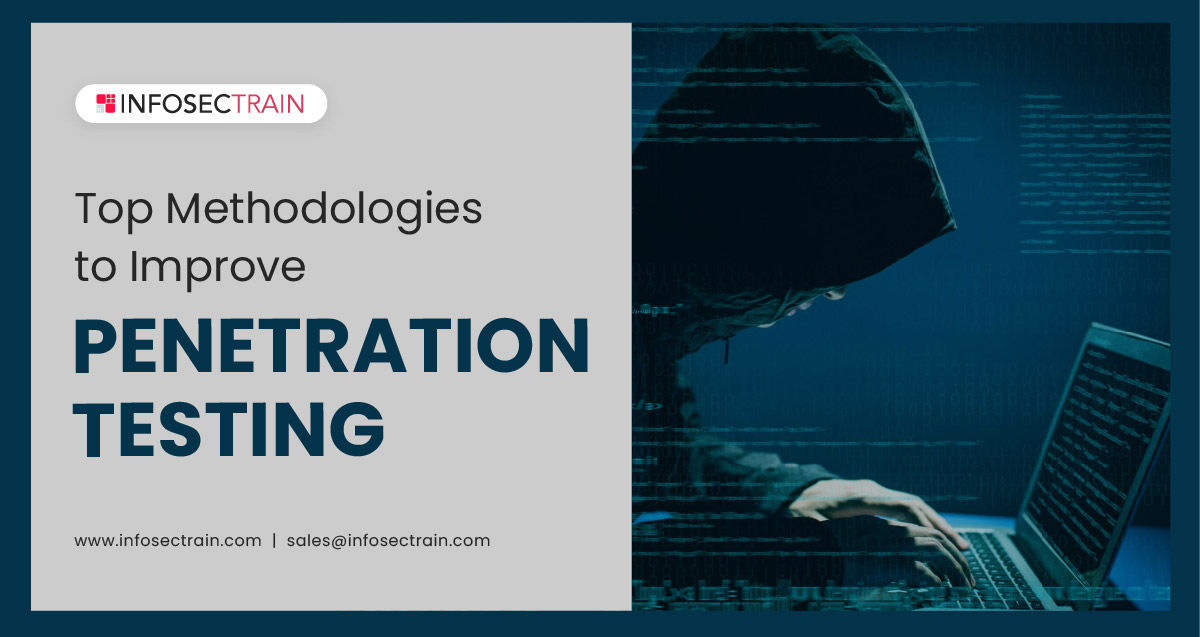Top Methodologies to Improve Penetration Testing
With the rapid progress of technology, your risk is overshadowed by a competitor that offers considerably more features and best-in-class security in their products than you do. Consumers in today’s digital environment need security and privacy and improved optimization for every program, software, website, etc.

Table of Contents
What is Penetration Testing?
Types of Penetration Testing
Top Penetration Testing Methodologies
However, it would be best to undertake security testing to build a security offering on your products. There are numerous security checks available for IT products, and penetration testing is one. So here, we will explain penetration testing and related methodologies.
What is Penetration Testing?
Penetration testing is a formal, systematic technique for assessing an organization’s overall security. This approach replicates a cyberattack on the organization’s security architecture, such as its network, apps, and users, to find vulnerable flaws. It evaluates the effectiveness of the organization’s security protocols, processes, and tactics. Penetration testers actually seek design flaws, operational weaknesses, and other vulnerabilities to enhance the system. The vulnerability assessment results are then extensively documented for top management and the necessary technical viewers.
Types of Penetration Testing
- Black Box Testing: A penetration tester is acquainted with the tested system. The hacker simulation is uninformed of the product’s IT infrastructure. As a result, the hacker launches an all-out effort to discover the IT structure and exploit some flaws.
- White Box Testing: White box testing is the opposite of black-box testing. The hacker possesses an understanding of source codes and software architecture.
- Gray Box Testing: Gray box penetration testing utilizes manual and automated procedures. This is done to establish a scenario where the hacker has just a basic grasp of the product’s IT system.
Top Penetration Testing Methodologies
A penetration testing methodology describes how a penetration test is planned and carried out. Penetration testing procedures aid in the systematic identification of security weaknesses in a corporation. These methodologies define an organization’s steps to detect flaws in their IT essential assets, offers, and processes. The following are the top industry-recognized and regarded penetration testing methodologies:
1. Open Source Security Testing Methodology Manual (OSSTMM)
One of the most well-known penetration testing approaches is the Open Source Security Testing Methodology Manual or OSSTMM. The Institute for Security and Open Methodologies (ISECOM) maintains a peer-reviewed methodology. Organizations can tailor their penetration tests to their individual needs with OSSTMM, while developers have direct connections to more secure areas of their surroundings for innovation. OSSTMM includes checks to make sure that laws and regulations are followed. OSSTMM is a universal go-to among penetration testing methodologies because it combines technical direction, device users for various locations, and broad support for different organization types.
2. Open Web Application Security Project (OWASP)
The Open Web Application Security Project (OWASP) is a set of standards and guidelines for the security of web applications frequently used as a starting point for IT professionals new to penetration testing. This methodology provides an approach for web application penetration testing that can detect typical web and mobile application vulnerabilities and complex logic issues resulting from poor design methods. Enterprises are best prepared with this methodology to secure their web and mobile applications against frequent flaws that can potentially affect the organization. Enterprises looking to create new online and mobile applications may consider implementing these principles during development to avoid exposing security problems.
3. Penetration Testing Execution Standard (PTES)
The PTES (Penetration Testing Execution Standards) Framework describes how to design the best penetration test. This specification directs testers through the many aspects of a penetration test, including initial communication, information collecting, and threat modeling. Here is the list of seven steps:
- Pre-engagement interactions
- Intelligence gathering
- Threat modeling
- Vulnerability testing
- Exploitation
- Post exploitation
- Reporting
4. National Institute of Standards and Technology (NIST)
Unlike all the other information security standards, NIST gives penetration testers more explicit instructions to follow. The National Institute of Standards and Technology (NIST) has a guidebook that can help an organization enhance its overall Cybersecurity. NIST establishes baseline standards for establishing technologies and stacks in a local ecosystem used in penetration testing.
5. Information System Security Assessment Framework (ISSAF)
The ISSAF (Information System Security Assessment Framework) standard takes a more systematic and professional approach to penetration testing than the other methodologies. It’s important to remember that the ISSAF includes more than just pen testing: it also includes developing tools to teach other people with network access. It also assures that people who use a network follow the appropriate legal guidelines.
Final Thoughts
Penetration testing procedures are an excellent way for organizations to include regular security assessments. Cyber hazards are becoming more prevalent in today’s world. Having a competent Pen Tester in your organization would be a huge advantage.
InfosecTrain offers comprehensive cybersecurity training courses that cover all relevant abilities. Certified Penetration Testing Professional (CPENT), CompTIA PenTest+, and Advanced Penetration Testing training courses are available from InfosecTrain.
TRAINING CALENDAR of Upcoming Batches For APT with KALI Linux
| Start Date | End Date | Start - End Time | Batch Type | Training Mode | Batch Status | |
|---|---|---|---|---|---|---|
| 27-Apr-2024 | 02-Jun-2024 | 09:00 - 13:00 IST | Weekend | Online | [ Open ] |





 1800-843-7890 (India)
1800-843-7890 (India) 
